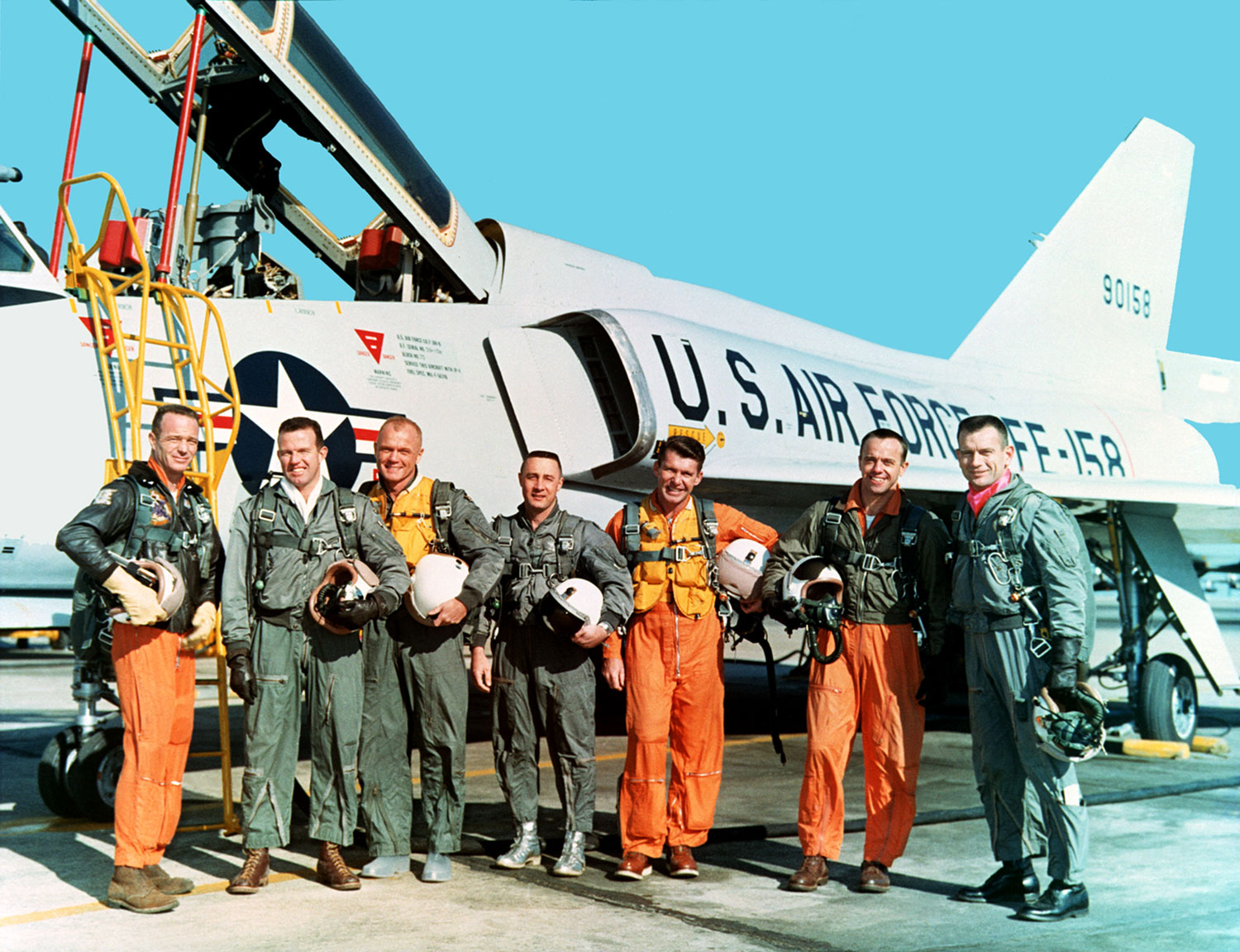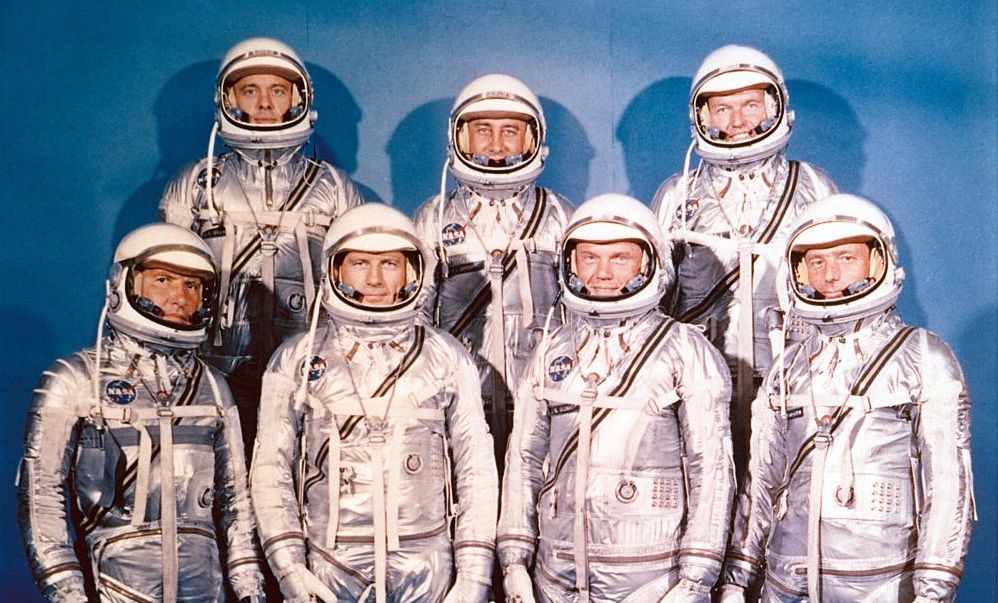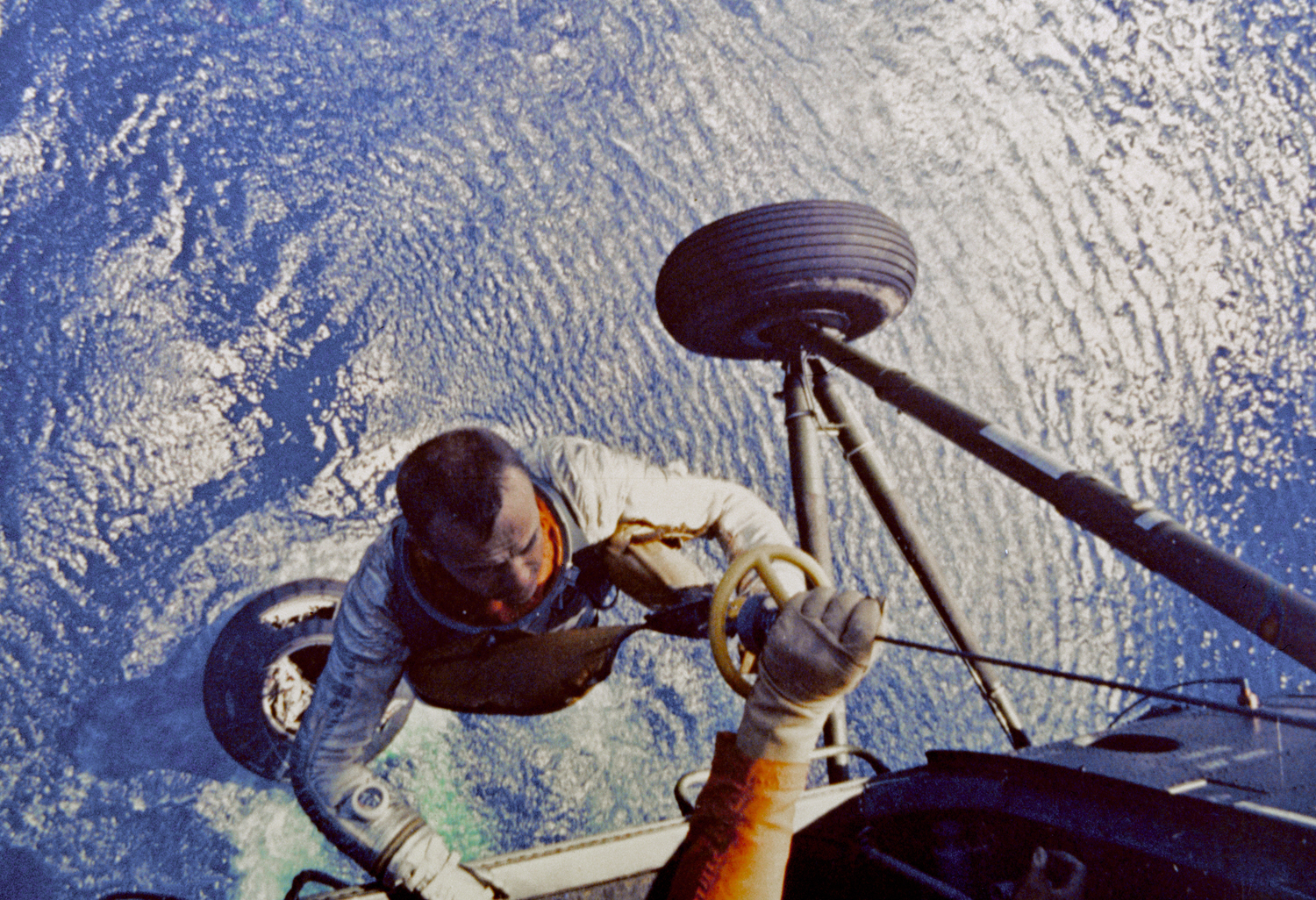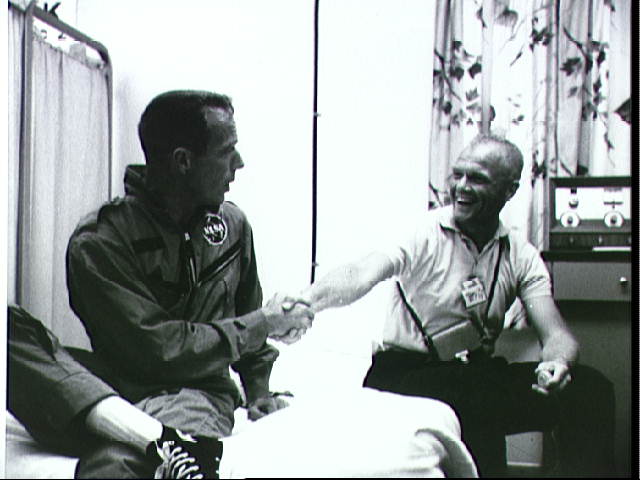Sixty Years On, America Remembers the Achievements, Sacrifice of the Mercury SevenBy Ben Evans, on April 9th, 2019
 Mercury astronauts John Glenn (3rd from left) and Scott Carpenter (far left) will headline NASA's “Celebrating 50 Years of Americans in Orbit" event at Kennedy Space Center Visitor Complex February 18. Photo Credit: NASAThe “Mercury Seven”, pictured in an early training photograph. From left to right are Scott Carpenter, Gordon Cooper, John Glenn, Virgil “Gus” Grissom, Wally Schirra, Al Shepard and Deke Slayton. Photo Credit: NASABest known as the residence of the fourth First Lady of the United States, on this day in 1959 the Dolley Madison House, opposite Lafayette Park in downtown Washington, D.C., provided the setting for the introduction of the United States’ first group of astronauts: the long-awaited “Mercury Seven”. Sixty years later, the names of Scott Carpenter, Gordo Cooper, Virgil “Gus” Grissom, Wally Schirra, Al Shepard, Deke Slayton and John Glenn have carved their own niche into America’s national psyche. From their ranks came the first U.S. spacefarer, the first American to orbit the Earth, the first human to make two (and three) orbital missions and one of their number even trod the dusty surface of the Moon. But at 2 p.m. EDT on 9 April 1959, the seven men—all clad in civilian suits, and with Glenn and Slayton wearing bow ties—were still virtual unknowns, about to be thrust into a spotlight of international fame.Sixty years ago, today, the Mercury Seven astronauts were introduced to the world. Video Credit: NASA/YouTube“Ladies and gentlemen,” said Walt Bonney, presiding officer for the event, “in about 60 seconds, we will give you the announcement you have all been waiting for: the names of the seven volunteers who will become the Mercury astronaut team.”
Mercury astronauts John Glenn (3rd from left) and Scott Carpenter (far left) will headline NASA's “Celebrating 50 Years of Americans in Orbit" event at Kennedy Space Center Visitor Complex February 18. Photo Credit: NASAThe “Mercury Seven”, pictured in an early training photograph. From left to right are Scott Carpenter, Gordon Cooper, John Glenn, Virgil “Gus” Grissom, Wally Schirra, Al Shepard and Deke Slayton. Photo Credit: NASABest known as the residence of the fourth First Lady of the United States, on this day in 1959 the Dolley Madison House, opposite Lafayette Park in downtown Washington, D.C., provided the setting for the introduction of the United States’ first group of astronauts: the long-awaited “Mercury Seven”. Sixty years later, the names of Scott Carpenter, Gordo Cooper, Virgil “Gus” Grissom, Wally Schirra, Al Shepard, Deke Slayton and John Glenn have carved their own niche into America’s national psyche. From their ranks came the first U.S. spacefarer, the first American to orbit the Earth, the first human to make two (and three) orbital missions and one of their number even trod the dusty surface of the Moon. But at 2 p.m. EDT on 9 April 1959, the seven men—all clad in civilian suits, and with Glenn and Slayton wearing bow ties—were still virtual unknowns, about to be thrust into a spotlight of international fame.Sixty years ago, today, the Mercury Seven astronauts were introduced to the world. Video Credit: NASA/YouTube“Ladies and gentlemen,” said Walt Bonney, presiding officer for the event, “in about 60 seconds, we will give you the announcement you have all been waiting for: the names of the seven volunteers who will become the Mercury astronaut team.”
Naval aviators Carpenter, Schirra and Shepard, Air Force pilots Cooper, Grissom and Slayton and Marine Corp veteran Glenn had been picked after three months of screening of 110 experienced combat and test pilots. The list had been winnowed through several phases of invasive and degrading medical and psychological evaluations. The pilots were divided into three groups, two of which were summoned secretly to the Pentagon in January 1959 for briefings on the NASA effort to put a man into space. Afterwards, the 69 candidates from the first two groups were asked if they wished to progress to follow-on tests and 90 percent of them agreed to do so. As a result, the now-unneeded third group was never called. The pilots’ enthusiasm came as a surprise to many on the selection panel. It was felt that they would be so entrenched in their military careers that the shift to a newly-formed civilian space agency for what was expected to amount to only two or three years would carry little appeal. Even Shepard’s father counseled his son that he might have made the wrong decision. Across four decades, from May 1961 through November 1998, the Mercury Seven flew aboard the Mercury, Gemini, Apollo and Space Shuttle Programs. Photo Credit: NASASixty-nine candidates dwindled to 32, who reported to Dr. Randy Lovelace’s aerospace medicine clinic in Albuquerque, N.M., for more evaluations. Schirra later described this battery of tests as “an embarrassment, a degrading experience…sick doctors, working on well patients”. Survivors of Lovelace’s clinic devised a tradition of inviting new candidates to dinner at a local Mexican restaurants. At their feet, each veteran had a jug of urine, which they had been instructed to collect for medical purposes. One evening, Grissom accidentally knocked over his jug, but the quick-thinking gathering of test pilots came up with a solution: order more beer. The result was that, after several rounds of drinks and numerous trips to the lavatory, Grissom’s jug was full again.
Across four decades, from May 1961 through November 1998, the Mercury Seven flew aboard the Mercury, Gemini, Apollo and Space Shuttle Programs. Photo Credit: NASASixty-nine candidates dwindled to 32, who reported to Dr. Randy Lovelace’s aerospace medicine clinic in Albuquerque, N.M., for more evaluations. Schirra later described this battery of tests as “an embarrassment, a degrading experience…sick doctors, working on well patients”. Survivors of Lovelace’s clinic devised a tradition of inviting new candidates to dinner at a local Mexican restaurants. At their feet, each veteran had a jug of urine, which they had been instructed to collect for medical purposes. One evening, Grissom accidentally knocked over his jug, but the quick-thinking gathering of test pilots came up with a solution: order more beer. The result was that, after several rounds of drinks and numerous trips to the lavatory, Grissom’s jug was full again.
Additional screening at the Aeromedical Laboratory of Wright-Patterson Air Force Base in Dayton, Ohio, saw the candidates having cold water pumped into their ears, sitting for hours in overheated saunas, enduring soundproofed and darkened isolation chambers, blowing up balloons until they were breathless and walking on treadmills until their hearts spiked at 180 beats per minute. Slayton doubed the tests’ usefulness. “I’d flown combat missions and done operational test flying for 17 years,” he wrote in his memoir, Deke, co-authored with spaceflight historian Michael Cassutt. “The fact that I’d survived should have told them all they needed to know about stress. At least putting me in the blackout chamber, they let me catch a nap!” After becoming America’s first man in space in May 1961, Al Shepard waited almost a decade before the chance to depart Earth a second time. Photo Credit: NASAEighteen diehard candidates survived these tests and their names were forwarded to the NASA selection committee, which originally intended to pick six astronauts; however, after firming choosing five names, the officials and doctors could not reach consensus between two other volunteers and wound up selecting them both. Carpenter, Cooper, Glenn, Grissom, Schirra, Shepard and Slayton all boasted IQs between 131 and 141, although examining psychologist Dr. George Ruff noted that each of the men was “oriented toward action, rather than thought”.
After becoming America’s first man in space in May 1961, Al Shepard waited almost a decade before the chance to depart Earth a second time. Photo Credit: NASAEighteen diehard candidates survived these tests and their names were forwarded to the NASA selection committee, which originally intended to pick six astronauts; however, after firming choosing five names, the officials and doctors could not reach consensus between two other volunteers and wound up selecting them both. Carpenter, Cooper, Glenn, Grissom, Schirra, Shepard and Slayton all boasted IQs between 131 and 141, although examining psychologist Dr. George Ruff noted that each of the men was “oriented toward action, rather than thought”.
In Light this Candle, Shepard’s biographer Neal Thompson explained that NASA wanted “steely, technology-savvy test pilots”, who were “mature…who’d been around, been tested and stuck it out”, rather than wet-behind-the-ears youngbloods for whom the fascination of being astronauts might lose its glamor when faced with the prospect of long hours and hard work. As a consequence, unlike the Soviet Union’s early cosmonauts, the U.S. astronauts were 25-40 years of age at the time of selection, with degrees in medicine, physical sciences of engineering and several years of professional experience, including test piloting credentials and over 1,500 hours in their flight logbooks. On 29 October 1998, at the age of 77, John Glenn became the oldest person ever to venture into space. It is a record which still stands. Photo Credit: NASA“The astronaut training program,” NASA Administrator T. Keith Glennan told the Dolley Madison audience that April afternoon, six decades ago, “will last probably two years. During this time, our urgent goal is to subject these gentlemen to every stress, each unusual environment they will experience in that flight.” The astronauts expected their preparation to include many hours in the cockpits of jet aircraft—“we didn’t know what else to train on,” Gordo Cooper remarked—but their actual training for one of the most audacious feats in human history would encompass much more: physical and psychological conditioning, together with intense technical, scientific and medical instruction, to enable them to understand the intricacies of the spacecraft and rockets upon which their lives would depend.
On 29 October 1998, at the age of 77, John Glenn became the oldest person ever to venture into space. It is a record which still stands. Photo Credit: NASA“The astronaut training program,” NASA Administrator T. Keith Glennan told the Dolley Madison audience that April afternoon, six decades ago, “will last probably two years. During this time, our urgent goal is to subject these gentlemen to every stress, each unusual environment they will experience in that flight.” The astronauts expected their preparation to include many hours in the cockpits of jet aircraft—“we didn’t know what else to train on,” Gordo Cooper remarked—but their actual training for one of the most audacious feats in human history would encompass much more: physical and psychological conditioning, together with intense technical, scientific and medical instruction, to enable them to understand the intricacies of the spacecraft and rockets upon which their lives would depend.
Spaceflight training had never been attempted and, in many ways, NASA and its first seven astronauts were forced to make it up as they went along. Indeed, Bob Gilruth, head of the Space Task Group, which included Project Mercury, stressed that they were not merely “hired guns” and that, unlike the military, “where direction comes from the top”, their direct input was expected and desired.
Two years later, in May 1961 Al Shepard became the first member of the Mercury Seven to fly and, in so doing, became the first American in space. His quarter-hour suborbital “hop”, boosted atop a converted Army Redstone missile, offered a welcome shot in the arm to the U.S. public, still smarting by Russia’s success, three weeks earlier, in flying Yuri Gagarin into orbit. Later that summer, Gus Grissom repeated Shepard’s 15 minutes in space and in February 1962 John Glenn circled the Earth three times aboard the Friendship 7 capsule. Scott Carpenter flew a science-heavy orbital mission in May 1962 and Wally Schirra spent nine hours aloft the following October, before Gordo Cooper logged a full day in space in May 1963 to close out the program. Left out of the running was Deke Slayton, grounded following the detection of a minor, persistent heart murmur. John Glenn (right) congratulates Scott Carpenter after his Mercury mission in May 1962. Eighteen months earlier, each of the Mercury Seven was asked to “peer-vote” which of their colleagues the thought was the best candidate for America’s first astronaut. Glenn placed Carpenter at the top of his list. Photo Credit: NASAWith Project Mercury concluded, Slayton became the first co-ordinator of astronaut activities. Shepard, too, was grounded throughout most of the 1960s, due to an inner-ear ailment, but returned triumphantly to flight status in January 1971 to command Apollo 14, in which he became the only member of the Seven to reach the Moon and walk on its surface. As for the others, Schirra flew the first rendezvous in space and became the only person to have flown aboard all three of the United States’ early manned orbital spacecraft: Mercury, Gemini and Apollo. Carpenter never flew again after his Mercury mission, Slayton eventually returned to flight status and flew Apollo-Soyuz in 1975, at the grand age of 51, and Grissom tragically died on the launch pad in the Apollo 1 fire of January 1967. Cooper flew the longest Mercury mission and one of the longest Gemini missions—indeed, for a few months in the summer and fall of 1965, he was the world’s most flight-experienced spacefarer—and Glenn, of course, after a quarter-century in politics, became the only member of the Mercury Seven to fly the Space Shuttle.
John Glenn (right) congratulates Scott Carpenter after his Mercury mission in May 1962. Eighteen months earlier, each of the Mercury Seven was asked to “peer-vote” which of their colleagues the thought was the best candidate for America’s first astronaut. Glenn placed Carpenter at the top of his list. Photo Credit: NASAWith Project Mercury concluded, Slayton became the first co-ordinator of astronaut activities. Shepard, too, was grounded throughout most of the 1960s, due to an inner-ear ailment, but returned triumphantly to flight status in January 1971 to command Apollo 14, in which he became the only member of the Seven to reach the Moon and walk on its surface. As for the others, Schirra flew the first rendezvous in space and became the only person to have flown aboard all three of the United States’ early manned orbital spacecraft: Mercury, Gemini and Apollo. Carpenter never flew again after his Mercury mission, Slayton eventually returned to flight status and flew Apollo-Soyuz in 1975, at the grand age of 51, and Grissom tragically died on the launch pad in the Apollo 1 fire of January 1967. Cooper flew the longest Mercury mission and one of the longest Gemini missions—indeed, for a few months in the summer and fall of 1965, he was the world’s most flight-experienced spacefarer—and Glenn, of course, after a quarter-century in politics, became the only member of the Mercury Seven to fly the Space Shuttle.Source:
https://www.americaspace.com/2019/04/09/sixty-years-on-america-remembers-the-achievements-sacrifice-of-the-mercury-seven/